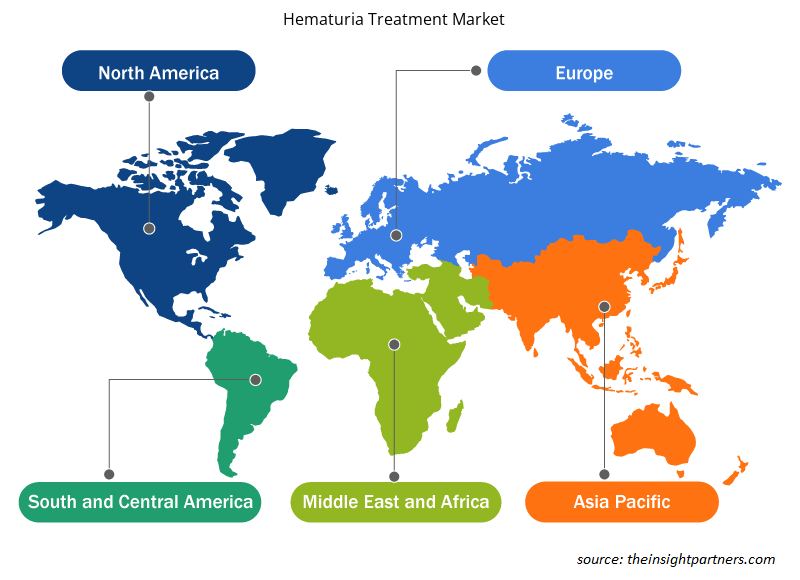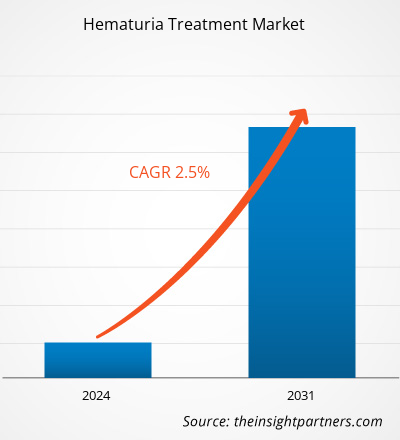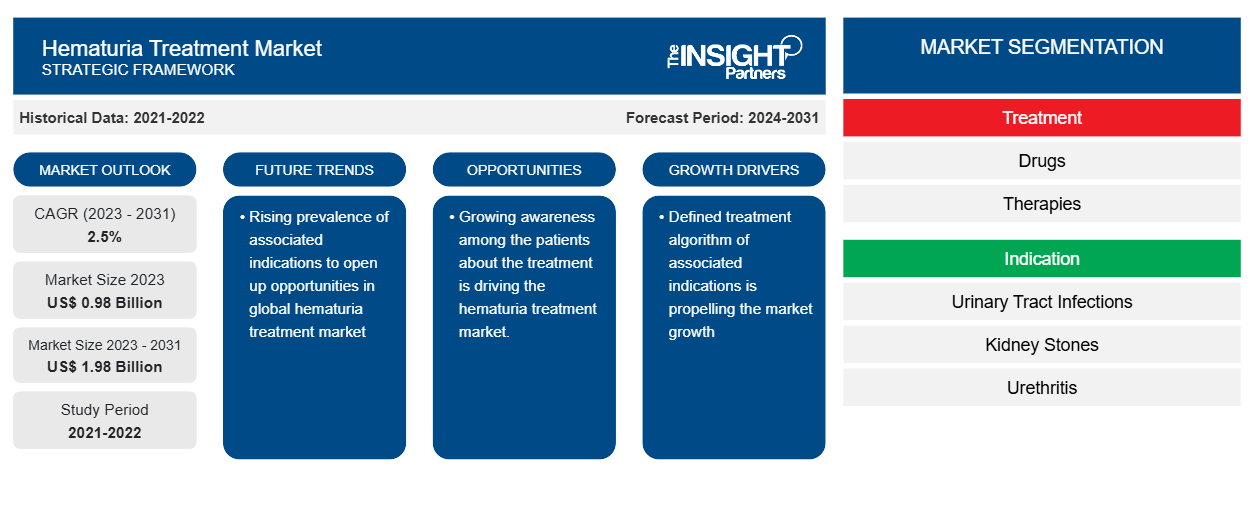Der Markt für Hämaturiebehandlungen soll von 0,98 Milliarden US-Dollar im Jahr 2023 auf 1,98 Milliarden US-Dollar im Jahr 2031 anwachsen. Für den Zeitraum 2023–2031 wird ein durchschnittliches jährliches Wachstum von 2,5 % erwartet. Die zunehmende Präferenz für fortschrittliche Therapien dürfte ein wichtiger Trend auf dem Markt bleiben.
Hämaturie-Behandlung Marktanalyse
Die wichtigsten Faktoren, die das Wachstum des Marktes vorantreiben, sind die hohe Prävalenz von mit Hämaturie verbundenen Indikationen, das zunehmende Bewusstsein für Behandlungsmöglichkeiten und die Verbesserung der Gesundheitsausgaben, die den Markt für Hämaturiebehandlungen ankurbeln. Darüber hinaus haben technologische Entwicklungen bei medizinischen Geräten und Diagnoseverfahren zu verschiedenen Optionen für die Behandlung von mit Hämaturie verbundenen Indikationen wie Nierensteinen, Blasensteinen und Harnwegsinfektionen geführt, die dem Markt für Hämaturiebehandlungen in den kommenden Jahren wahrscheinlich Chancen bieten werden.
Marktübersicht zur Hämaturiebehandlung
Chronische Nierenerkrankungen (CKD) sind eine weit verbreitete und lebensbedrohliche Erkrankung, die weltweit viele Menschen betrifft. Es gibt verschiedene Arten von CKDs, wie Nierensteine, Glomerulonephritis, polyzystische Nierenerkrankung und Harnwegsinfektionen. CKD ist eine der Hauptursachen für die Prävalenz von Hämaturie. Laut einer im Mai 2019 im National Center for Biotechnology Information veröffentlichten Studie werden Harnwegsinfektionen (HWI) in den USA beispielsweise im Allgemeinen als ambulante Infektionen beobachtet und treten meist bei Frauen im Alter zwischen 14 und 24 Jahren auf. Darüber hinaus beträgt die Prävalenz von HWI bei Frauen über 65 Jahren etwa 20 % im Vergleich zur Gesamtbevölkerung, die bei etwa 11 % liegt. Derzeit profitiert der globale Markt für Hämaturiebehandlungen erheblich von der zunehmenden Verbreitung der damit verbundenen Indikationen.
Passen Sie diesen Bericht Ihren Anforderungen an
Sie erhalten kostenlos individuelle Anpassungen an jedem Bericht, einschließlich Teilen dieses Berichts oder einer Analyse auf Länderebene, eines Excel-Datenpakets sowie tolle Angebote und Rabatte für Start-ups und Universitäten.
-
Holen Sie sich die wichtigsten Markttrends aus diesem Bericht.Dieses KOSTENLOSE Beispiel umfasst eine Datenanalyse von Markttrends bis hin zu Schätzungen und Prognosen.
Markttreiber und Chancen für die Behandlung von Hämaturie
Sensibilisierung für Behandlungsmöglichkeiten und Verbesserung der Gesundheitsausgaben
Die Gesundheitsausgaben sind aufgrund der zunehmenden Verbreitung chronischer Erkrankungen erheblich gestiegen. Die Regierungen verschiedener Volkswirtschaften investieren erheblich in die Verbesserung der Gesundheitsinfrastruktur. Laut den im Dezember 2020 von den US-amerikanischen Centers for Medicare & Medicaid Services (CMS) veröffentlichten Daten stiegen beispielsweise die nationalen Gesundheitsausgaben (NHE) um etwa 4,6 %, 11.582 US-Dollar pro Person, und machten etwa 17,7 % des Bruttoinlandsprodukts (BIP) aus. Darüber hinaus prognostizierte CMS, dass die Gesundheitsausgaben in den USA im April 2020 voraussichtlich etwa 6,19 Billionen US-Dollar erreichen werden.CMS), the National Health Expenditure (NHE) increased by about 4.6%, US$ 11,582 per person, and accounted for about 17.7% of gross domestic product (GDP). In addition, CMS projected that the health care spending in the US is expected to reach about US$ 6.19 trillion in April 2020.
Darüber hinaus werden sich Patienten in Industrieländern der möglichen Behandlungen und der Kostenerstattung für die Hämaturiebehandlung bewusst. Hämaturie ist eines der ersten Anzeichen chronischer Krankheiten wie Blutkrebs, Blasenkrebs und Nierenkrebs. Diese Krankheiten werden von verschiedenen Krankenversicherungen abgedeckt, die die Behandlung der Patienten erleichtern und die finanzielle Belastung der Gesundheitsversorgung verringern. Daher treiben die Verbesserung der Gesundheitsausgaben und das Bewusstsein der Patienten für die Behandlung den Markt für Hämaturiebehandlungen an.hematuria treatment. Hematuria is among the initial indications of chronic diseases such as blood cancer, bladder cancer, and kidney cancer. These diseases are covered under various health insurance policies that help ease the treatment of the patients and reduce the financial burden of healthcare. Thus, improving healthcare expenditure and awareness among patients about the treatment is driving the hematuria treatment market.
Mehr Möglichkeiten für verwandte Behandlungen
Die alternde Bevölkerung, die aufgrund der Zunahme von Nierensteinen und Harnwegsinfektionen häufiger an Hämaturie erkrankt, ist einer der Haupttreiber für das Wachstum des Marktes. Der Einsatz moderner Behandlungstechnologien soll die Patientenversorgung verbessern. So hat beispielsweise der Einsatz von Robotern bei Operationen zur Behandlung von Urolithiasis in den letzten Jahren an Popularität gewonnen. Derzeit wird das Vinci Surgical System von Intuitive Surgical Inc. häufig bei Operationen zur Behandlung von Urolithiasis eingesetzt . Ebenso hat die Anwendung endourologischer Eingriffe bei Nierensteinen in verschiedenen nordamerikanischen, europäischen und asiatischen Ländern deutlich zugenommen. Es wird auch erwartet, dass Fortschritte bei damit verbundenen Indikationen den globalen Markt für Hämaturiebehandlungen im Prognosezeitraum unterstützen werden.hematuria disease due to an increase in kidney stones and urinary tract infections, is one of the main drivers propelling the market's expansion. The use of advanced treatment technologies is expected to enhance patient care. For instance, the implementation of robotics in surgeries for treating urolithiasis has gained popularity in recent years. Currently, Vinci Surgical System, by Intuitive Surgical Inc., is widely used in performing surgeries to treat endourological interventions for kidney stones has increased significantly across various North American, European, and Asian countries. It is also expected that advancements in associated indications will support the global hematuria treatment market during the forecast period.
Segmentierungsanalyse des Marktberichts zur Hämaturiebehandlung Treatment Market Report Segmentation Analysis
Wichtige Segmente, die zur Ableitung der Marktanalyse zur Hämaturiebehandlung beigetragen haben, sind Produkttyp, Indikationstyp und Endbenutzer.hematuria treatment market analysis are product type, indication type, and end user.
- Basierend auf der Behandlung ist der Markt für Hämaturiebehandlungen in Medikamente, Therapien und Sonstiges unterteilt. Das Medikamentensegment hatte im Jahr 2023 den größten Marktanteil.hematuria treatment market is segmented into drugs, therapies, and others. The drugs segment held the most significant market share in 2023.
- Basierend auf der Indikation ist der Markt für Hämaturiebehandlungen segmentiert nach Harnwegsinfektionen, Nierensteinen, Urethritis, Blutkrebs, Blasensteinen, Prostatakrebs, Blasenentzündung, Trauma, intensiver körperlicher Betätigung, polyzystischer Nierenerkrankung, Endometriose und Menstruation. Das Segment Harnwegsinfektionen hatte im Jahr 2023 den größten Marktanteil.hematuria treatment market is segmented by urinary tract infections, kidney stones, urethritis, blood cancer, bladder stones, prostate cancer, cystitis, trauma, vigorous exercise, polycystic kidney disease, endometriosis, menstruation. The urinary tract infections segment held the largest market share in 2023.
- Basierend auf dem Endverbraucher ist der Markt für Hämaturiebehandlungen unter anderem nach Krankenhäusern, Kliniken und ASCs segmentiert. Das Krankenhaussegment hatte im Jahr 2023 den größten Marktanteil.hematuria treatment market is segmented by hospitals, clinics, and ASCs, among others. The hospital's segment held the largest market share in 2023.
Hämaturie-Behandlung Marktanteilsanalyse nach Geografie Treatment Market Share Analysis by Geography
Der geografische Umfang des Marktberichts zur Hämaturiebehandlung ist hauptsächlich in fünf Regionen unterteilt: Nordamerika, Asien-Pazifik, Europa, Naher Osten und Afrika sowie Süd- und Mittelamerika.
In Nordamerika sind die USA der größte Markt für Hämaturiebehandlungen. Das Wachstum dieses Marktes wird vor allem durch die zunehmende Verbreitung chronischer Nierenerkrankungen (CKD) und die wachsende Zahl von Produkteinführungen durch wichtige Akteure vorangetrieben. So gaben die Centers for Disease Control and Prevention (CDC) im Jahr 2016 an, dass in den USA schätzungsweise 0,7 Millionen Menschen wegen Nierenversagen im Endstadium (ESRD) behandelt wurden. Die Prävalenz von ESRD hat sich zwischen 1990 und 2016 mehr als verdoppelt. Darüber hinaus wird erwartet, dass die Zunahme der Hämaturieinzidenz bei Erwachsenen, das gestiegene Bewusstsein und umfangreiche Forschungs- und Entwicklungsaktivitäten die Verbreitung von Hämaturiebehandlungen vorantreiben werden, was letztendlich eine lukrative Chance für das Wachstum des Marktes bieten wird.
Regionale Einblicke in den Markt für Hämaturiebehandlungen
Die regionalen Trends und Faktoren, die den Markt für Hämaturiebehandlungen im Prognosezeitraum beeinflussen, wurden von den Analysten von Insight Partners ausführlich erläutert. In diesem Abschnitt werden auch die Marktsegmente und die Geografie für Hämaturiebehandlungen in Nordamerika, Europa, im asiatisch-pazifischen Raum, im Nahen Osten und Afrika sowie in Süd- und Mittelamerika erörtert.

- Erhalten Sie regionale Daten zum Hämaturie-Behandlungsmarkt
Umfang des Marktberichts zur Hämaturiebehandlung
| Berichtsattribut | Details |
|---|---|
| Marktgröße im Jahr 2023 | 0,98 Milliarden US-Dollar |
| Marktgröße bis 2031 | 1,98 Milliarden US-Dollar |
| Globale CAGR (2023 - 2031) | 2,5 % |
| Historische Daten | 2021-2022 |
| Prognosezeitraum | 2024–2031 |
| Abgedeckte Segmente |
Nach Behandlung
|
| Abgedeckte Regionen und Länder |
Nordamerika
|
| Marktführer und wichtige Unternehmensprofile |
|
Dichte der Marktteilnehmer zur Behandlung von Hämaturie: Auswirkungen auf die Geschäftsdynamik verstehen
Der Markt für Hämaturie-Behandlungen wächst rasant. Dies wird durch die steigende Nachfrage der Endnutzer aufgrund von Faktoren wie sich entwickelnden Verbraucherpräferenzen, technologischen Fortschritten und einem größeren Bewusstsein für die Vorteile des Produkts vorangetrieben. Mit der steigenden Nachfrage erweitern Unternehmen ihr Angebot, entwickeln Innovationen, um die Bedürfnisse der Verbraucher zu erfüllen, und nutzen neue Trends, was das Marktwachstum weiter ankurbelt.
Die Marktteilnehmerdichte bezieht sich auf die Verteilung der Firmen oder Unternehmen, die in einem bestimmten Markt oder einer bestimmten Branche tätig sind. Sie gibt an, wie viele Wettbewerber (Marktteilnehmer) in einem bestimmten Marktraum im Verhältnis zu seiner Größe oder seinem gesamten Marktwert präsent sind.
Die wichtigsten auf dem Markt für Hämaturiebehandlungen tätigen Unternehmen sind:
- AstraZeneca
- Merck & Co., Inc.
- Bristol-Myers Squibb Company
- Merck & Co., Inc.
- F. HOFFMANN-LA ROCHE LTD.
- GlaxoSmithKline plc.
Haftungsausschluss : Die oben aufgeführten Unternehmen sind nicht in einer bestimmten Reihenfolge aufgeführt.

- Überblick über die wichtigsten Akteure auf dem Markt für Hämaturie-Behandlungen
Neuigkeiten und aktuelle Entwicklungen zum Hämaturie-Behandlungsmarkt
Der Markt für Hämaturiebehandlungen wird durch die Erhebung qualitativer und quantitativer Daten nach Primär- und Sekundärforschung bewertet, die wichtige Unternehmensveröffentlichungen, Verbandsdaten und Datenbanken umfasst. Nachfolgend sind einige der Entwicklungen auf dem Markt für Hämaturiebehandlungen aufgeführt:
- Farxiga (Dapagliflozin) von AstraZeneca wurde in den USA zugelassen, um das Risiko eines kardiovaskulären (CV) Todes, eines Krankenhausaufenthalts wegen Herzinsuffizienz (CHF) und dringender Arztbesuche wegen Herzinsuffizienz (HF) bei Erwachsenen mit HF zu senken. Die Zulassung durch die Food and Drug Administration (FDA) basierte auf positiven Ergebnissen der Phase-III-Studie DELIVER.1 Farxiga war in den USA zuvor für Erwachsene mit HF mit reduzierter Ejektionsfraktion (HFrEF) zugelassen. (Quelle: AstraZeneca, Unternehmenswebsite, Mai 2023)
Marktbericht zur Behandlung von Hämaturie – Umfang und Ergebnisse
Der Bericht „Marktgröße und Prognose zur Hämaturiebehandlung (2021–2031)“ bietet eine detaillierte Analyse des Marktes, die die folgenden Bereiche abdeckt:
- Marktgröße und Prognose zur Behandlung von Hämaturie auf globaler, regionaler und Länderebene für alle wichtigen Marktsegmente, die im Rahmen des Berichts abgedeckt sind
- Markttrends und Marktdynamiken für die Behandlung von Hämaturie wie Treiber, Einschränkungen und wichtige Chancen
- Detaillierte PEST/Porters Five Forces- und SWOT-Analyse
- Marktanalyse zur Behandlung von Hämaturie, die wichtige Markttrends, globale und regionale Rahmenbedingungen, wichtige Akteure, Vorschriften und aktuelle Marktentwicklungen umfasst.
- Branchenlandschaft und Wettbewerbsanalyse, die die Marktkonzentration, Heatmap-Analyse, prominente Akteure und aktuelle Entwicklungen auf dem Markt für Hämaturie-Behandlungen umfasst
- Detaillierte Firmenprofile
- Historische Analyse (2 Jahre), Basisjahr, Prognose (7 Jahre) mit CAGR
- PEST- und SWOT-Analyse
- Marktgröße Wert/Volumen – Global, Regional, Land
- Branchen- und Wettbewerbslandschaft
- Excel-Datensatz
Aktuelle Berichte
Erfahrungsberichte
Grund zum Kauf
- Fundierte Entscheidungsfindung
- Marktdynamik verstehen
- Wettbewerbsanalyse
- Kundeneinblicke
- Marktprognosen
- Risikominimierung
- Strategische Planung
- Investitionsbegründung
- Identifizierung neuer Märkte
- Verbesserung von Marketingstrategien
- Steigerung der Betriebseffizienz
- Anpassung an regulatorische Trends























 Kostenlose Probe anfordern für - Markt für Hämaturiebehandlung
Kostenlose Probe anfordern für - Markt für Hämaturiebehandlung